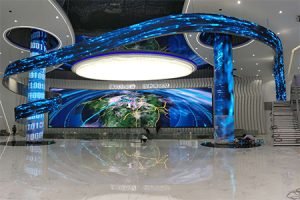The LED display industry has noticed that the original cob packaging process has the characteristics of reliability and stability, so it is introduced into the LED display industry to make up for the shortage of LED display screen spacing below P1.0. However, the reality is that since the introduction of cob packaging process, it has been in an embarrassing position and has not been widely recognized by the industry colleagues. The main reason is that cob belongs to the industry “Subversive” process technology is incompatible with the original machines and equipment, and the yield rate is low, which makes it impossible to mass produce. As a result, the cost of the entire cob module remains high. Generally, only the government or high-value projects will be applied. Some data show that the market share of cob display products is only between 2.4% by 2018.
In recent years, with the rise of 5g / 8K ultra high definition display technology and the recent popularity of mini backlight products, the good news about micro spacing products has been constantly spread, and the relevant stock market is also rising all the way. In this regard, LED display enterprises are also keen to launch a variety of micro pitch products. However, on the road to micro pitch products, there are a variety of different technical routes. There are two popular ones, one is the “subversive” packaging process based on flip chip cob, the other is the “four in one” mini It is worth mentioning that since the launch of the “four in one” chip devices, some enterprises have been involved. In the packaging end, there are jingtaixing, Hongqi, Yiguang, Guoxing optoelectronics, Dongshan precision and so on. In the application end, there are listed enterprises such as liad, abison, LianJian optoelectronics and Alto electronics.
The reporter of 3qled has done research on the development direction of micro pitch products, and many of them said that the “four in one” SMD devices will show a good development trend in 2-3 years, but in the long run, the future must be the world of flip chip cob. Among them, Wang Yang, deputy general manager of Changchun Xida Electronic Technology Co., Ltd., said that from the technical level, the “four in one” product welding feet still exist, which can not solve the air tightness problem of lamp bead edge, and can not break through the bottleneck of SMD point spacing development. From the display effect, the “four in one” product has stronger sense of particle, serious discrete pockmarks in the side view, single specification, and no defects According to the later maintenance and use, the “four in one” lamp bead pad is exposed, the surface gap is easy to accumulate dust, and it is easy to bump and damage in the handling, installation and use. The later maintenance cost is higher, and the flip cob has absolute advantages relative to these problems In addition, the homogenization problem of “four in one” products is serious, and the reliability and stability still need to be improved.
Coincidentally, Sun Ming, general manager of mini Optoelectronic Technology Co., Ltd., also holds the same view. He said: the success of flip chip cob is inevitable. For example, a 4K screen contains 8.3kk pixels. One pixel of the front mounted “four in one” chip device has 13 solder joints, 3 red lights, 5 green lights and 5 blue lights, while flip chip cob has only 6 solder joints. There is a full difference of 7 between the two In LED display products, more solder joints will not only affect the yield, but also cause the chip and even the whole pad scrap.
In addition, from other data, flip chip cob belongs to panel level packaging, which directly encapsulates LED light-emitting chips on PCB board. Compared with “four in one”, flip chip cob not only has higher protection performance, but also is easier to meet the demand of products in micro space field.
2.jpg
To be sure, flip chip cob has obvious advantages, but there is still a long way to go. Some enterprises hold a “wait-and-see” attitude. The main reason is that flip chip cob is a “subversive” process. If flip chip cob technology is widely used, it means that the original LED manufacturers abandon their old machines and equipment, start a new stove, and re create an ecological chain, which is very important for the original led factories It’s a very “uncomfortable” choice for manufacturers. In addition, the cost is also a key consideration. Some relevant organizations have compared the costs of SMD, four in one and cob. It is concluded that the cob process cost is the highest. It is not only difficult to produce in the early stage, but also faces a series of problems in the later after-sales and maintenance.
However, with the development of LED display technology, all these have changed. The most obvious is that the price of LED display has decreased year by year, and it has a place in the field of commercial display. For example, not long ago, Lehman optoelectronics released two mass production products of p0.79 and p0.63 micro based on micro LED pixel engine display technology According to Tu Menglong, senior director of the R & D center of the company, the pixel engine technology is an organic combination of LED chip hardware layout and software algorithm, which can greatly improve the resolution of the display screen on the premise of increasing the amplitude and reducing the cost. This kind of technological innovation solves the cost problem to a certain extent. In addition, the director of Lehman optoelectronics Co., Ltd Chang Li MANTIE also admitted that the price of cob has dropped and it is possible to be the same as traditional SMD.
Moreover, the current micro LED technology is in the ascendant, limited by the massive transfer technology, has not been able to mass production, and micro spacing products, as the forefront of micro led, has been attracting people’s attention. Flip chip cob has introduced the LED display into the era of integrated packaging, and its development is bound to provide a reference for the development of micro led Therefore, the industry believes that the success of flip chip cob is inevitable and will promote the development of next generation display technology.



